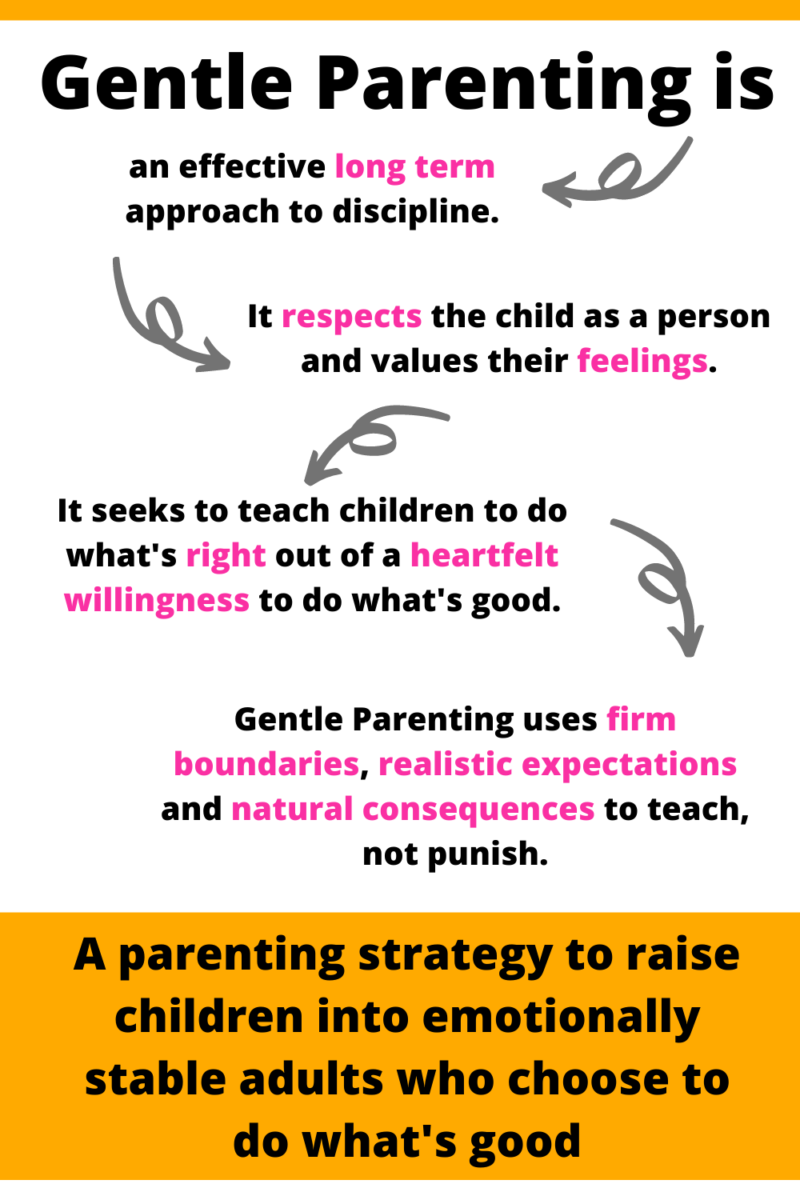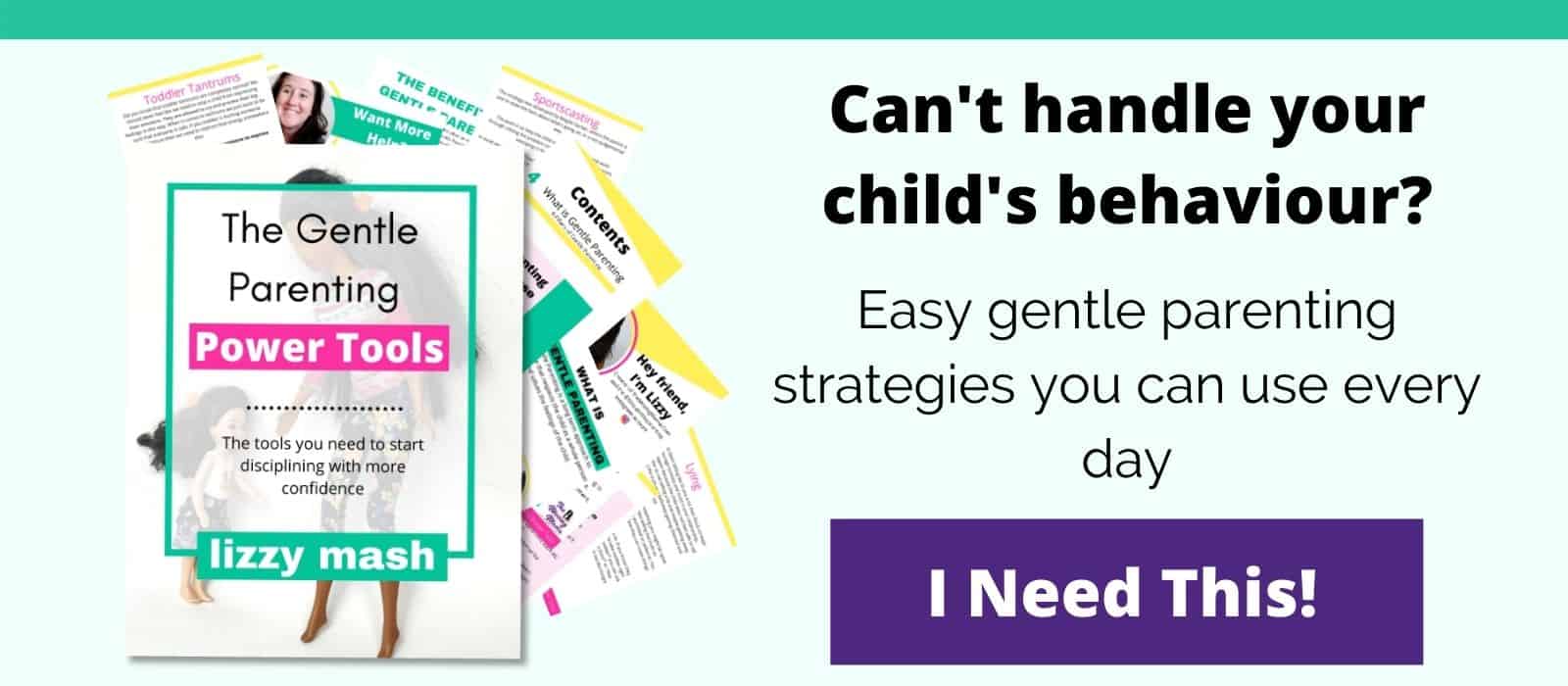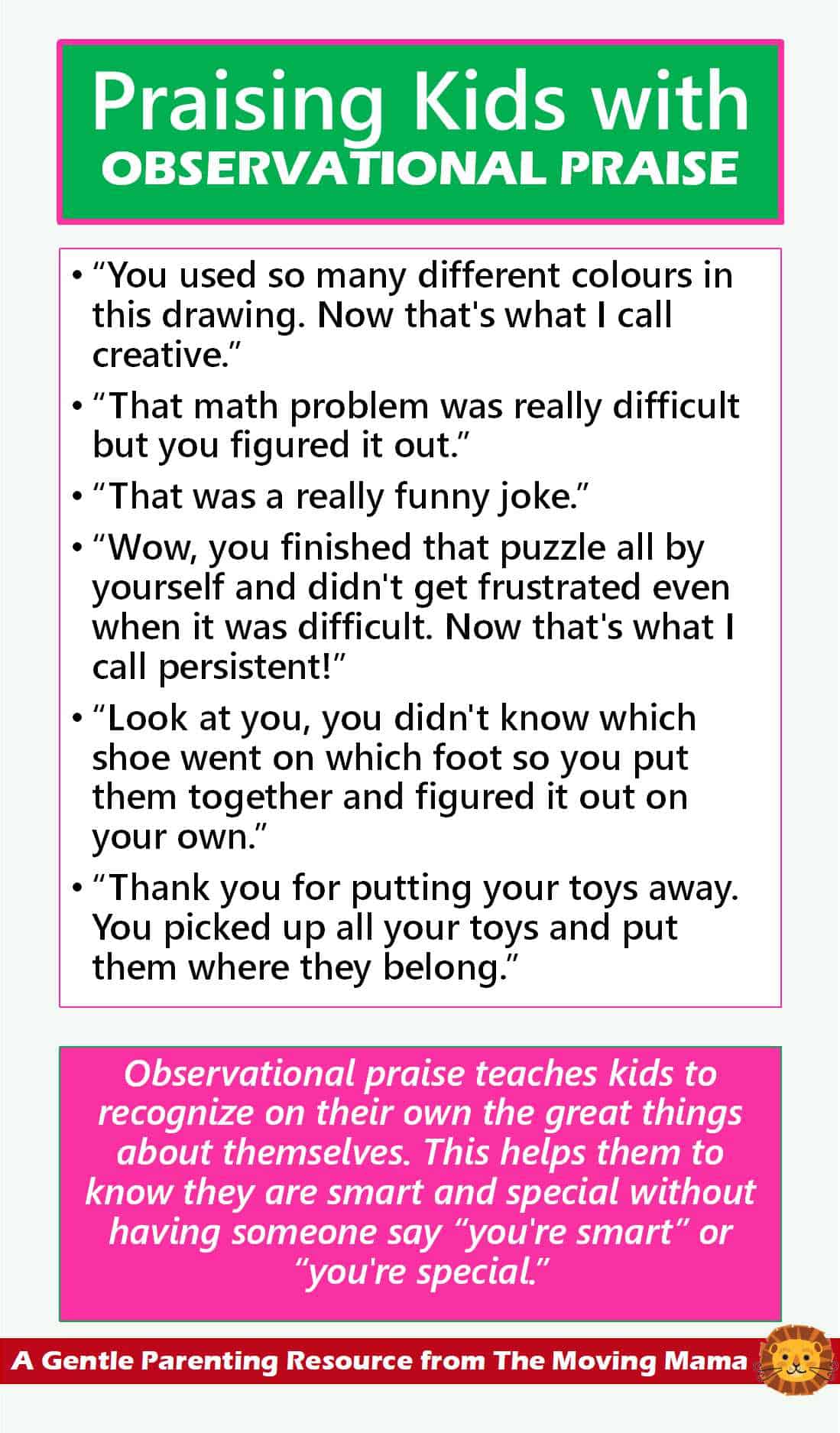Using Boundaries Instead of Rules With Kids
Have you ever had a toddler who insisted on climbing onto the dining table?
No matter how much you redirected them or told them not to they just kept doing it? You even start to feel nervous about it because you know they could easily fall and hurt themselves? Your nerves turn to frustration and you end of feeling overwhelmed by how challenging it is that they keep climbing on the table.
This is a case where a parent should set a boundary.
Setting boundaries is an extremely important part of Gentle Parenting, so I’m going to explain to you exactly what it is and how to do it.

(This post might contain affiliate links, which means if you happen to buy a product I love then I may get a commission – at no extra cost to you! For all the Ts and Cs go here.)
But first of all, what even is Gentle Parenting?
Gentle Parenting is the discipline strategy I promote here at “Easy Gentle Parenting,” because it is a respect-based style of discipline. No punishments, spankings, “naughty chairs,” sticker charts or bribes to get your child to do the right thing!

If you are completely new to Gentle Parenting you might want to grab one of my free resources, such as my Gentle Parenting Power Tools Ebook below.

What are boundaries and limits?
Setting boundaries and limits takes our child’s development into account so we can set up the environment in a way that helps them to succeed.
Instead of expecting our child to be able to say “no” to every impulse they have, we will set them up for success. Instead of leaving the cookie jar within their reach when we know they don’t have the self-control to stay out of it, we’ll put it where they can’t get it.
Setting boundaries might mean making things out of their reach or babyproofing so it’s physically impossible for them to do the thing you don’t want them to do, but it can also mean things like always supervising your children when you know one sibling often gets in fights with the other. You recognize that they can’t handle being alone much so you need to keep an eye on them and so you consistently do so.
Examples of boundaries and limits
To help give you a better idea of what boundaries and limits are, here are some examples that parents have set for their young ones before. Most boundaries have to do with safety (for your child, another child or yourself) but privacy and hygiene can also be involved.
- Holding down your child’s hand as they try to hit someone – “I won’t let you hurt me. I am holding your hand down to keep myself safe.”
- Having to brush your child’s teeth – “I know you don’t like to brush your teeth, but it’s my job to take care of you so let’s do it slowly.”
- Setting up baby gates – This keeps your mobile baby or toddler safe by not giving them access to things that could hurt them, but it also helps you take care of your things if there are things you don’t want them to break.
- Keeping items out of reach – “I know you really want to touch my coffee but it’s too hot that I’m going to put it on the counter to keep you safe.” This can also mean not even giving them access to certain things they are allowed to play with but only with supervision, such as crayons until they are old enough to know not to colour on anything besides paper.
- Supervising children when they play outside – This might mean they can’t play outside as much as they want if you have to be busy inside with certain tasks, but if your children are not responsible enough to play outside without fighting or doing something they shouldn’t, then the boundary you would set is that they always need supervision.
- Holding hands to cross the street – Even if they don’t like it, this may be a boundary you have to uphold for the sake of their safety.
- Limiting screen time – Perhaps you will only allow them to have a certain amount of screen time and this is a limit you set for them, then it’s up to you to make sure there is consistency even when they try to push the limits.
- Only allowing certain toys to be played with in the house and certain toys outside – If you don’t want the jump rope to come in the house or maybe stuffed animals shouldn’t go outside, than this can be a boundary you set and discuss the reasons with your child to help them understand which toys they shouldn’t take outside, and which toys they shouldn’t bring inside.
You can read about a specific way to handle boundaries with your kids in this blog post – What to Do When 4 Year Old Needs Constant Attention.
But I do hear a lot of parents saying this…
“But my child always tests any boundaries I set for them!”
Yes, this is actually pretty common. Maybe one boundary you have is bedtime. You know your child functions best with a certain bedtime so you always stick to getting them to bed around that time.
Your child very well may test that limit, and as the parent it’s up to you to just stick with it as long as that limited is needed. Sometimes children will test limits so they can see exactly where the line is. Testing really isn’t a bad thing, it might be a bit annoying for you, sure, but for your child they are figuring out where the boundary is and looking to see if it’s always there. Consistency is key for boundaries because it helps children to see exactly where the boundary is and to know it will always be there.
Testing boundaries can also mean your child is communicating a need. It might be there way to say, “Play with me,” or “I’m tired” or “I’m confused.” All behaviour is communication, so just try to listen to what your child is trying to say.
Related: 10 Easy Ways to Prevent Toddler Running Away
Boundaries need to be firm, but not harsh
Boundaries are different from traditional “rules.” They aren’t something that you need to expect your child to follow 100% of the time otherwise they will get a punishment. When we set boundaries for our children we can explain why that boundary is there (for example, to keep them safe) and give our children the respect of an explanation.
Rules often expect a child to follow them perfectly without much support, but a boundary actually enables the child to do the right thing. For example, a rule might be “No climbing on the dining table,” but your toddler keeps doing it anyways and therefore “breaking a rule,” but a boundary might be moving the chairs to another room to prevent them from climbing on the table at all.
So boundaries should be set in a firm (and loving) way but not a harsh, “my way or the highway” sort of way.
Remember, I am advocating for Gentle Parenting here with is the perfect balance between permissive parenting and authoritarian parenting.

After some time, boundaries in your home will change depending on the age and development of your child. The curious toddler who pulls everything off the low shelves will eventually be the pre-schooler who you can expect not to do that. So for a season you might keep all your books up high, but eventually that boundary won’t need to be there anymore.
This is crucial for boundaries to be successful…
Before I get into exactly how to set a boundary for your child, I want to mention something very crucial to your success with using boundaries:
Understanding your child.
Some people won’t support the idea of setting boundaries because they think a baby/toddler/child needs to learn not do certain things.
This might mean the parent won’t babyproof because they want the baby to be trained not to do certain things. I understand the thinking here, but the truth is that can be quite a lot to expect out of a little one whose brain is still developing for years to come.
Impulse control might not happen until your child is close to 5 or 6 years old. This means expecting them to resist the most tempting, desirable actions is usually expecting too much. It will be difficult for them to meet those expectations, and frustrating for both of you if they’re consistently letting you down.
For little ones, there is a wide range in what one child will be tempted to do than another child. Some toddlers just don’t care about climbing on the dining table so you don’t even think about it, where others are obsessed so the point that you have to keep the chairs in another room except at meal time in order to keep them safe. So just because something seems “easy” for your friend’s child, doesn’t mean that it’s easy for your own child. It might be a lot more tempting for your child, and harder for them to have self-control in that area.
Honestly, even as an adult there are times that I don’t end up on the better side of a decision because my lack of self-control makes me go for something I shouldn’t. Have you ever over-spent when you told yourself you needed to save? Have you ever spilled a secret when you were trying to bite your tongue?
Even as adults, self-control isn’t easy and our brains are done developing! So imagine how it must be for someone so young with a developing brain.
And the truth is, you really don’t need immediate obedience from your child. You don’t need them to have perfect self-control right now, but you need to give them opportunities to learn so they can eventually choose to do the right thing all on their own.
Setting boundaries will give your child more confidence because setting boundaries makes it so much easier for them to do what they’re supposed to do.
So understand where your child is coming from, and it will be much easier to set boundaries for them.
How to set a boundary
Ok, now it’s time for your to set some boundaries in your home.
These are the steps for you to take
#1. Choose the boundary
#2. Make any physical changes
#3. Communicate the boundary
#4. Stay consistent with the boundary
#1. Choose the boundary
Here are somethings to consider if you need to add new boundaries right now:
- Is there a rule my child is always breaking? How can I turn that into a boundary to help them do the right thing?
- Is there something my child keeps doing and they get hurt?
- How can I set a boundary that will prevent siblings from fighting or hurting each other?
When you set a boundary, it should be something that is necessary and explainable. You want to be able to explain to your child why you are setting a boundary. It’s so much easier to do what someone wants when you know WHY they want you to do it.
And when you set a boundary, it’s important to do so way before it becomes absolutely necessary. Don’t wait until you’re completely fed up and then spring a new boundary on your child. Try to think and plan ahead so you can set up the necessary boundaries for your child at their current age and development.
#2. Make any physical changes
Does furniture need to be rearranged or any baby proofing done? Do you have to re-organize any rooms so your child can no longer access things that you don’t want them to have access to?
#3. Communicate the boundary
If this is a brand new boundary it’s important that you talk to your child about it to help them understand. If they’re still really little you can still give them a simple explanation, but for older children it’s good to appeal to their rational side and explain the boundary.
Keep in mind that boundaries are there to empower your child, not to make them feel bad for past mistakes. Maybe you will say, “From now on when you want to colour I want us to be in the same room together and when you’re done I will put the crayons and markers away.”
You don’t have to spend time telling them how bad it was last time when they used the crayons and markers on the walls, and how upset it made you feel and that you were disappointed in them. Focusing on their mistakes might seem like it will drive the point home and they’ll never do it again, but that isn’t a respect based parenting strategy. Using positive language can play a big role in getting our children to do the right thing, so think about the words you choose to use when explaining new boundaries for your child.
If you want to learn more about positive language you might be interested in this post: 5 Steps to Be A Parent Overflowing With Positive Language
#4. Stay consistent with the boundary
As I mentioned to you earlier, consistency is key because it helps your child to see exactly where the boundary is. It gives them predictability and assurance that that definitely is the boundary.
Inconsistency and actually changing the boundary are different though, if the boundary is no longer needed then feel free to change it. Now of course you might change the boundary and quickly realize it was too soon so then you have to go back to it. This isn’t inconsistency, but inconsistency would mean changing all the time how you responded with the boundaries being tested.
How to hold a boundary
Once you’ve set some boundaries for your children it might be hard to hold those boundaries overtime, especially when your child is testing the boundaries. Here are some tips to use to help you hold the boundaries.
#1. Explain the reason for the boundary
As discussed, explaining the purpose of the boundary will help your child to stick with it or accept it. Explain the boundary in a way that shows that you have faith in them, not as if the boundary is a punishment for something they’ve done in the past.
#2. Hold the boundary in a “matter of fact” way
Boundaries don’t need to be an emotional issue, just hold the boundary in a matter of fact way.
“You need to have clean teeth to stay healthy, so we have to brush your teeth.”
Bring the concerns for safety, hygiene, etc. into the picture to make your matter of fact statement. It doesn’t have to be harsh or manipulative but just a, “This is how it is because ____” while also showing your child respect in the process.
#3. Redirect them
Depending on their age, it can be easy enough to just redirect them to another activity with maybe a bit of a reminder about that boundary.
You can say something simple like, “Oops, let’s stay seated at the table for colouring. If you’re finished we can put the markers away and do something else.” This would help redirect your child if you see them getting up while holding a marker, maybe with an idea on their mind to colour on something besides paper.
A simple and gentle redirection can go a long way.
Related: How to Get a Toddler to Listen
#4. Use observational praise
It will be easier for your child to hold the boundaries set for them if they feel good about sticking to them. When they are respecting the boundaries that have been set be sure to use observational praise as a way to encourage them.
Observational praise means you can comment on what you see rather than just saying, “Good job.” Here are some examples to give you a better idea of how to use observational praise.

#5. Respect their boundaries in return
Believe it or not, your child might have some boundaries they want you to up hold as well.
Do they get freaked out when you use the vacuum, or maybe they hate having their hair brushed? They might wish there were boundaries set to make these things easier for them.
Maybe with vacuuming you could always give them a warning that you’re going to do it, or hold them when it’s happening. My daughter used to be terrified of the vacuum but now we have a routine where I give her very fair warning that I’m going to start and she climbs up on the couch and stays there until I am done. I could just try to do it as fast as possible, but this wouldn’t be respecting her boundary when it comes to the vacuum and how she feels about it.
Respecting your child’s boundaries might also be with their privacy, especially if you want them to respect your privacy in return.
When your child is able to have reasonable boundaries of their own, and you choose to respect their boundaries, it will be much easier for them to uphold the boundaries being set on them.
What to do when a boundary is crossed
When a boundary has been/is being crossed here’s what you can do:
- Physically stop the action – If it’s something dangerous you may need to stop them or remove them from the situation
- Make it right – Help anyone who got hurt, clean up any mess created, etc.
- Remind them of the boundary and why it’s there
- Make the boundary firmer if necessary – Is this boundary being crossed a lot? What needs to change?
- Move on – They will learn through experience and time, no need for a long lecture
Always remember to stay patient with your child through it all. It might be frustrating and difficult for you, but they are still learning. Our littles ones need our love and grace as they attempt to figure out this big world around them.
Boundaries should work for both parties
In the end, you want the boundaries to work for both you and your child.
For yourself you might have certain goals like to…
- Keep your child safe
- Keep your other children safe
- Take good care of the belongings in your home
- Take good care of their health
- Maintain privacy for each family members
And for your child, with these boundaries, there are things you’d want for them as well…
- For them to learn to make good choices
- Have fun
- Have confidence that they can do the right thing
- For them to feel respected as a whole person
Boundaries should work for both parties.
Boundaries should empower your child to make good decisions, instead of just forcing them into doing what you want them to do. This is why explaining them is so important.
If keeping a boundary takes your child’s dignity away, you may need to readdress how that boundary is being held. It doesn’t mean the boundary is wrong, but often our approach to holding it is where our children can end up feeling hurt. You want the boundary to work for you, but also for your children.
Boundaries are your friend when it comes to Gentle Parenting. They will empower your child to just be a child! Limit the things that they struggle to control themselves with, and create boundaries that will help them learn to make the right choices.
Continue the learning
If this strategy seems so new to you and so foreign from most parenting advice out there…then you’re not alone!
Gentle Parenting isn’t mainstream (yet) when it comes to disciplining your kids. Maybe you’ve been frustrated by parenting advice in the past, and just didn’t feel content with the information that was out there for you. It can be disheartening when all the advice you’re getting goes against what you believe in as a parent when you want to take a respect-based approach.
So I’ve got your back!
If you want to learn more sign up below for my 2 weeks to Gentle Parenting challenge and also be sure to check out some of my most popular posts:
How to Explain Gentle Parenting to Your Parents or In-Laws
6 Steps to Stop Being an Angry Mom

